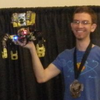Dtto Modular Robot
|
|
Dtto Modular Robot Basic Data Category: Robotics URL (first publication): https://hackaday.io/project/9976-dtto-explorer-modular-robot
Project status:
Technical documentation Maturity of the project:
no no
Other
Assembly instructions are editable: Bill of materials is editable: Design files are in original format: No Free redistribution is allowed licence: No
Project management
Open-o-meter: 0 Product category: Electronics Contains original non-electronic hardware: Contains original electronic hardware: Contains original software: |
Inhaltsverzeichnis
Description
Dtto - Explorer Modular Robot
Modular self-reconfigurable robot, focused on all-terrain search and rescue operations using bio-inspired locomotion mechanisms
Become a Hackaday.io member
Not a member? You should
Team (5)
Related lists
Domo Arigato Mr. Roboto
Hackaday Prize Entries using Atmel parts
Starts April 25th - Ends May 30th / You’re an independent thinker, a troublemaker, and have no respect for the status quo.
Creative resident teams building hardware projects in Art, Design, Technology, and Science.
This project is submitted for
This project was created on 03/03/2016 and last updated 9 months ago.
The Dtto Robot is a modular transformable robot designed to be versatile, flexible and self-reconfigurable. The idea of modular robots is that they can adopt any shape they want, by changing the position and the connection of their modules.
The small size, the versatility and the limitless shapes it can adopt, make Dtto the perfect robot for all kind of search and rescue operations.
Full project:
Check out our shared , were we are discussing and proposing new ideas and concepts for the next version of the Dtto Modular Robot
2016HackadayPrize Final Video
The problem
In most natural disaster situations, like hurricanes, earthquakes, fires, there are situations where people get trapped without the possibility to get out to safety by themselves. Then is when search and rescue operation teams come at play. Nowadays, most of the search and rescue operations are carried out by humans, needing a lot of specialized manpower and hours of work to look for possible survivors.
After working at Ground Zero on the WTC, Dr. Robin Murphy, Professor of Computer Science at University of South Florida, who was working with search and rescue robots, said:
“Robots proved helpful” ; “Using robots can minimize the number of personnel on site, and reduce the fatigue and errors” ; She sees mobile robots as scouts able to navigate, adapt and perceive. ; ”Robots will be manpackable” ; “so small that they can fit into small subhuman confines, able to tell their orientation as they snake throught open spaces in rubble” ; “ going where no human should go”
Source: ()
How it works
In robotics, the usual approach for designing exploration robots is: First, study the terrain characteristics and then, designing a robot according to those needs. When moving trough an unexplored and unpredictable terrain like an earthquake affected building, you never know which kind of obstacles will you find. There is where modulars robots can do really well.
The Dtto Modular Robot has been designed with adaptability in mind. Inspired by how fire ants colonies work, a number of modules (or small robots) find each other, connect mechanically and colaborate to act as one only robot, creating a collective inteligence. They can link together and bulid structures without any central comand. The advantatge of being all modules the same is that, if one of them breaks, it can easily get replaced by another one, creating a self-healing structure.
By changing its configuration, the Dtto robot can move like a snake through a small pipeline, then transform into a wheel-like robot to move faster, then transform to a centipede robot when there is no vertical space and finally build a bridge to get to the other side of the hanging floor.
Expandability
While looking for the minimum size, the robot is designed to contain almost all the electronics and motors in one half, so that there is a large free space in the other half.
That free space can be used to install a thermal camera, microphone and speakers, multiple sensors, more actuators (like grippers) or even more batteries.
SPECS
- Small and self-contained robot
- Self-reconfiguration capabilities
- Bluetooth + Radio communication
- Multiple locomotion modes (snake, wheel, walker )
- Rechargable batteries
- Simulation model validated
- Cheap modules (<55 USD)
- Open Source Hardware and Software
- FIRST OPEN-SOURCE SELF-RECONFIGURABLE MODULAR ROBOT
Special thanks to Dr. Jose Luís Ramírez, and to Dr. Juan González-Gómez “Obijuan”, for their support and help everytime I needed it.
It has been fully printed with open-source 3D printers, uses open-source hardware and has been designed entirely on FreeCad.
This robot is Inspired by the MTRAN III, by The National Institute of Advanced Industrial Science and Technology (AIST), Japan. ()
The CAD files, and STL printing files are located in the FILES and in the github repository)
This project and all of it's files, images, videos and texts are entirely licensed under the CC BY-SA 4.0 license. ()
VIDEOS:
More videos:
Hexapod simulation. It's designed to facilitate the addition of up to 9 pair of legs, but I haven't tried it yet :D ttt - 440.51 kB - 09/18/2016 at 19:03 |
Files to simulate the robot in V-REP |
STL files |
- 1 × Arduino Nano v3.0 2x if IR detection enabled (optional)
- 2 × TowerPro MG92B Servomotor
- 3 × TowerPro SG90 Servomotor
- 1 × Bluetooth HC-05
- • 03/16/2018 at 11:38 •
Here is a short video demonstrating the connection mechanism inside a rotating face:
And these are some of the different versions of each of the parts of the module. It still needs a huge amount of work to do
- • 06/06/2017 at 22:21 •
This is how it looks the mechanical structure for the next version of the Dtto modular robot.
It will be using this small metal gear motors with huge reduction, so that we can get way more torque than on the previous generation.
Now I'm testing the durability of these white machined Delrin gears. They are lighter than the brass ones, and we need the modules to be as light as possible
- • 05/03/2017 at 17:17 •
Here's a preview of all the coupling mechanisms + face rotation assembled
- • 04/19/2017 at 16:38 •
Now I'm finally working full time on the project And I have access to awesome 3D printers and CNCs and cool things at the Supplyframe DesignLab :).
The most critical part on the modules is the coupling mechanism that holds them together. This is a second design for holding the modules together:
Alberto
- • 03/27/2017 at 16:58 •
Hello
These days we've been trying to design a small mechanism that allows the 4 hooks to rotate with the full face of the module. The idea is that, when mechanically connected, the modules can change their relative position (for example, to change from a 2D worm structure to a 3D snake movement).
This is the first test, with the 4 hooks on the rotating plate:
Having rotating faces at both ends of the modules, we could use them as wheels to move on flat surfaces.
Still a looooot of work to do, we will keep working
- • 01/31/2017 at 09:35 •
Hello there
We are now a small group of people actively working on the project Some things that we are currently trying to improve are:
- Smaller coupling mechanism
- Controller software
- Robot software (We still need some software guys interested in robotics :D)
- Redesign of the module: Same size, +1 DOF
We are working together in this ; it´s open for everyone to see what´s happening inside :)
If you are interested in sharing something with us, please, don´t hesitate to contact us and we will add you to the workteam
Thanks
Alberto
- • 10/20/2016 at 18:07 •
Hello there
Hoping to answer some questions, here you can find the mathematical equations describing the serpentinoid movement:
The studies by Hirose were the first ones on modelling the snake movement:
Hirose, Satoshi. Biologically Inspired Robots (Snake-like Locomotor and Manipulator.: Oxford Science Press, 1993.
You can also check this derived paper:
Simulation Study of Snake-like Robot’s Serpentine Locomotion Based on Recurdyn
; by Wang Nan, Pang Bo and Zhou Sha-Sha)
(I will probably make a document with all the documentation I´ve used as soon as I can…)
Thanks
- • 09/27/2016 at 19:00 •
Hellooo,
Today I want to share with you some pictures of the clones we already have
The following pictures are from our friend , from France :
And here we have the pictures from our friend Nansong, China, who almost have now more modules than myself :D :
Thanks
- • 09/14/2016 at 22:02 •
Hello
Today I got the robot to walk like an hexapod robot so here you have a video
Hope you enjoy this weird evolutions until the final one, haha
Alberto
- • 09/02/2016 at 16:22 •
Hello
It's been a while but today I've uploaded all the simulation files I've created so far You can simulate the robot, test different parameters and even create your own robot configurations
Here's a video showing the simulator in action:
Thanks
Alberto
- 1Step 1
This is an illustrated guide on how to assembly a module (v2) for the Dtto Modular Robot.
- Bill of Materials
- Schematics
Components:
Quantity
Description
22
1
Arduino Nano v3.0
1
HC-05 Bluetooth Module
1
NRF24L01+ Wireless Transceiver
24
Neodimium Disk Magnets (4x3mm)
2
TowerPro MG92B Servomotor
3
TowerPro SG90 Servomotor
2
Li-Po Battery 3,7V 600mAh 25C
1
LM317 Voltage Regulator
1
Mini Switch
1
WS2812 RGB LED
40
M1.7x4mm Self Tapper Screw
1
330 Ohms Resistor
1
1200 Ohms Resistor
4
520 Ohms Resistor
3
Small Rubber Band (dental braces)
This tutorial will show how to assembly a fully working Dtto Modular Robot module. We strongly recommend you to have close by a rasp (nail file, emery board, sandpaper) and a set of precision blades.
First of all, we need to print all the parts of the robot. For this type of project, whe think that ABS plastic it’s better because it is more machinable than others. The .stl files are available in the links in the first page. You also have a link to a pdf file detailing how many parts we need, each Part Nº and some details (List of 3D Printed Parts). We will be using the Part Nº to identify the parts. We also need the schematics file to check the connections.
Once we have all our parts printed, all supports removed and carefully sanded, we can proceed to the assembly of the module.
Note: In this tutorial we won’t be assembling the IR detection system. This feature will be available as soon as possible.
We do not take any responsibility and we are not liable for anything occurred while assembling and working with this modular robot. :)
- 2Step 2
We need:
- 2 x Part 004-1
- 1 x Part 011-1
First of all, we have to ensure these 3 parts fit perfectly. It is very important that the 004-1 Parts rotate freely around the center. The easier they rotate, the less energy is lost in friction -> the robot moves better.
- 3Step 3
We need:
- 2 x MG92B Servomotor
- 4 x 520 Ohms Resistor
The second thing to do is to adapt the MG92B Servomotors to turn the full 180 Degrees. The method we used was to add a couple resistors to each servo control circuit:
- Take apart the back cover of the servomotor (4 screws).
- Carefully separate the control circuit from the inside. The potentiometer is located under the circuit (it may be covered by a black film). Once you can access the 3 pins of the potentiometer,you have to unsolder the first and the third cable (not the center one). Then, you have to solder a 520Ohms resistor to each of these two pins, and then solder the cable to the resistor. You can find tutorials on how to modify servomotors (search: Modify servo 180 degree), but it’s important you use the 520 Ohms resistors (in the pictures we used one 680 and one 2200 Ohms resistors in parallel to get the 520 Ohms).
- The control circuit does not fit the casing anymore, so we are going to stick it to the side of the metal case (see pictures). Protect the circuit from short-circuits with some tape on both sides.
- Repeat the procedure for the other servomotor
Enjoy this project?
ShareDiscussions
Are you sure?
Are you sure?
Are you sure?
Are you sure?
Are you sure?
Are you sure?
Are you sure?
Are you sure?
Are you sure?
Are you sure?
Are you sure?
Are you sure?
Are you sure?
Are you sure?
Are you sure?
Are you sure?
Are you sure?
Are you sure?
Are you sure?
Are you sure?
Are you sure?
Are you sure?
Are you sure?
Are you sure?
Are you sure?
Are you sure?
Are you sure?
Are you sure?
Are you sure?
Are you sure?
Similar Projects
Does this project spark your interest?
to follow this project and never miss any updates
By using our website and services, you expressly agree to the placement of our performance, functionality, and advertising cookies.
Report project as inappropriate
You are about to report the project "Dtto - Explorer Modular Robot", please tell us the reason.
Send message
Your application has been submitted.
Remove Member
Are you sure you want to remove yourself as a member for this project?
Project owner will be notified upon removal.
+ General Reviews 
Public cad repository for non-electronic hardware
Public cad repository for electronic hardware
Public code repository
Assembly instructions
of Materials.pdf Bill of materials
Link github





